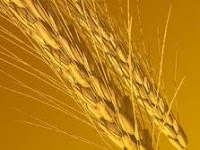"Russian Prime Minister Vladimir Putin, responding to the country's crippling drought and deadly wildfires, said on Thursday that exports will be banned from Aug. 15 until the end of the year..."Look at what has happened to the price of wheat in the last few months:
 |
| NY TIMES |
Most people have a "ho-hum" reaction when it comes to commodities like wheat, corn, soy beans, etc. But these are important inputs into so many finished food products. When we have negative supply shocks like the one in Russia it affects the economy at both the macro and micro level.
In the global market for wheat there has been a reduction in supply due to drought AND fires in the highly productive regions of Russia (Ukraine, especially). Now added to the mix is a mandate by the Russian President that wheat is subjected to an export ban. Graphically, the supply curve for wheat is going to shift to the left, indicating a decrease in market supply (at any given price, the quantity supplied is less than what it was before--graph those new points and you get a new supply curve (S1) that lies to the left of the previous one (S*).
As supply curve S1 shifts to the left, notice we MOVE ALONG the existing Demand Curve D*. Demanders are responding to the supply reduction by DECREASING the quantity demanded of wheat as the price of wheat increases, as the Law of Demand would suggest. Think of it this way: as the price goes up then some demanders are simply not going to be part of the market as they were before because they are "not willing and/or able" to purchase the same quantities of wheat at the new higher price P1 (or maybe none at all now). The difference between market quantity from Qe to Q1 illustrates this reduction in BOTH quantity supplied due to weather, fire, government policy and the quantity demanded due to the higer price. Here is an example of the decrease in quantity demanded from the article:
They are not completely out of the market, but the higher price is limiting their ability to purchase the same amount as before, hence the decrease in quantity demanded.""The wheat price spike has forced the U.N. World Food Program, which helps feed more than 90 million people world-wide, to cut back on purchases, according to a spokeswoman""
On a Microeconomics level this is only the begining--how is this going to affect farmers/ranchers, aid organizatioins, food processors, retail and wholesale businesses in terms of the cost of production? On the Macoeconomics level--globalization, government policies that affect world trade, allocation of resources (as planting season approaches, is wheat a better bet than corn, soy beans, cotton, etc)? Is this a start of a broader increase in food prices resulting in harmful inflation? Will the rise in price for this essential input cause food riots in some countries?
Something as simple as wheat can have a large impact on our lives is so many ways...This is why I love economics!! So much to consider and ponder...


Yes, I understand your concern, but you must understand that Russia should not feed the whole world and his people not to pay attention. Now because of the drought and fires in the central part of Russia, which has always collected a record harvest of wheat crop averages 78 million tons of wheat. for comparison, last year collected more than 100 million tons.
ReplyDeleteDuM4uK---Thank you for your comment. It is a difficult situation. From an economics teachers perspective, I enjoy (if that is the appropriate word to use)observing the interaction between politics and economics. It creates some interesting results, some good and some not so good or even disasterous. We will have to see how this works out in the end...THANKS!! :)
ReplyDelete